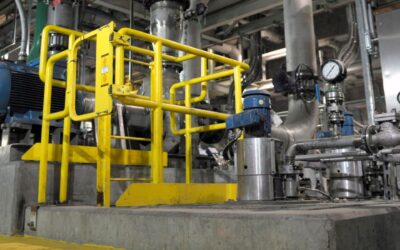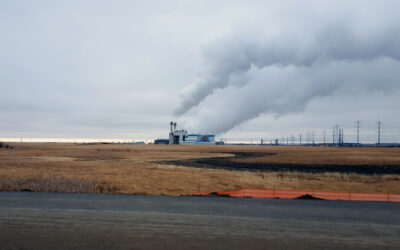Large-emitter trading systems (LETS) are the workhorse of Canada’s climate policies, according to a recent analysis from the Canadian Climate Institute. The study finds that these carbon pricing policies—which are also sometimes called output-based-pricing systems (OBPS)—are doing more to reduce climate pollution between now and 2030 than any other policy.
This finding has rightly turned some heads. How do LETS work, and could they be adjusted to be even more effective? This blog seeks to provide some answers.
LETS plug leaks
Large-emitter trading systems matter most for sectors that are emissions-intensive and trade-exposed. Firms that make goods like steel, cement, or aluminum, for example, produce relatively large amounts of greenhouse gas emissions per unit of output, and compete in international markets against companies that may not face a price for those emissions. Climate policy that creates significant new costs for them could therefore allow their international competitors to undercut them and take their business. This can lead to leakage—where carbon pricing doesn’t deter a polluting activity, but just causes it to pop up elsewhere. LETS offer a way of reducing emissions while also limiting leakage.
How LETS work
Instead of pricing emissions from a firm’s inputs—like the diesel or coal it uses—LETS price the emissions associated with a firm’s output, such as tonnes of cement or steel. But firms only pay the carbon price if they exceed a certain threshold of emissions intensity (these thresholds are usually called performance standards or benchmarks, and they can vary by product, facility, or sector). Firms that emit above the threshold have to buy credits to cover their excess emissions. Firms that meet the threshold are not liable for the carbon price. And firms that emit less than the threshold generate credits that they can sell to the other firms for a profit.
Further below, we’ll talk about why this approach makes sense. But first, let’s walk through a hypothetical example.
An example
Let’s consider four aluminum manufacturers: A, B, C, and D. To keep things simple, we’ll assume they each have one facility, and that they all produce the same amount of primary aluminum—300,000 tonnes per year.
Where our four firms differ is in their emissions. Each has a different emissions intensity of production, as Figure 1 illustrates.
Let’s say the performance standard for the large-emitter trading system in our example is two tonnes of CO2 per tonne of aluminum produced (the same as Firm A’s emissions intensity). In our example, the LETS measures every aluminum firm against this sectoral threshold of emissions intensity. (In practice, different LETS set thresholds in different ways. Some systems, like Alberta’s Technology Innovation and Emissions Reduction regulation, set firm-specific standards rather than sector-wide ones.)
Firms pay the carbon price on any emissions that exceed the threshold. Figure 2 shows the difference between the threshold and their actual emissions intensity for the year. Firm A aligns with the threshold, and so it has enough credits to cover its emissions. Firm B’s emissions intensity falls below the threshold, so it ends up with surplus credits. Firm C is more emissions-intensive than the threshold, and so it ends up with a modest shortfall in credits. Firm D, which has the highest emissions, ends up with a more significant shortfall.
Let’s assume the price of carbon is $80 per tonne (as it currently is in all of Canada’s carbon pricing systems). That means that the firms’ actual costs can be calculated by multiplying their remaining emissions (i.e., the emissions that they don’t have credits for) by $80. The bigger the gap, the bigger the cost for the firm.
Figure 3 shows each of the four firms’ average cost per tonne of carbon pollution.
In our example, Firms C and D face carbon costs given the relatively high emissions intensity of their production. The more they emit per unit of output, the more they pay, on average, per tonne of pollution. Firm A, on the other hand, gets rewarded for its relative efficiency by paying no price on carbon, while Firm B’s even greater efficiency earns it a net benefit in the form of revenue from the sale of its excess credits.
LETS make sense
LETS lower costs for firms while driving down emissions. Let’s boil down the key benefits of LETS:
- LETS address concerns about leakage and competitiveness
Under LETS, firms have an incentive to reduce emissions by cleaning up their production, instead of simply reducing it. In our example above, if companies had to pay the full carbon price on their emissions, they might find themselves struggling to compete with their international peers not subject to a carbon price. If this pushed them out of business, international competitors could be expected to take their place in the market. This would mean economic costs for Canada, and little benefit in the form of falling global greenhouse gas emissions. LETS help avoid this outcome. Reducing production would reduce the number of credits available to a firm. This means there’s no incentive for firms to cut their emissions by cutting production, potentially displacing their emissions to other jurisdictions.
- LETS use trading to provide flexibility
Even though LETS lower costs for firms, they maintain incentives from the carbon price to produce goods and services that have lower emissions. Credits in these systems are valuable. In fact, their value is exactly the carbon price (in our example, $80 per tonne). Because the credits are tradable, covered firms have incentive to take any action that reduces emissions—for example, electrification, or upgrading to more efficient processes or equipment—that costs less than $80 per tonne. Doing so would allow them to sell a surplus permit on the market (or avoid having to buy one). This flexibility means that the incentive that carbon pricing provides to improve the emissions-intensity of production is left intact. The incentive should also grow over time, since the carbon price for LETS rises at the same rate as the consumer-facing carbon price.
- LETS maintain incentives for low-carbon innovation
LETS’ flexibility also means that they preserve the incentive for firms to develop innovative technologies and processes that reduce emissions. Top-performing firms can sell their excess credits—at a steadily increasing price that’s defined by the price of carbon—giving them a competitive advantage. The possibility of this competitive advantage encourages other firms to reach this performance level themselves—and critically, to exceed it. This creates a built-in incentive for ongoing innovation and improvement.
A word of caution
To ensure LETS remain effective at reducing pollution from Canada’s largest emitters, regulators must act to address markets with an oversupply of credits. In some provinces, lax thresholds and interactions with other climate policies may contribute to a glut of credits. Where there are too many credits, their value falls and so does the incentive to reduce emissions, making LETS less effective. Setting stricter thresholds, as the Climate Institute recommends, is therefore vital to preserving the benefits of large-emitter trading systems.








